This is a report-out of a deeply insightful Open Space session at Agile Games 2012. How do we achieve greatness and great results? This post explores key factors such as fear, risk safety, vulnerability and much more.
Inherent Risk, Personal Baggage and Controls
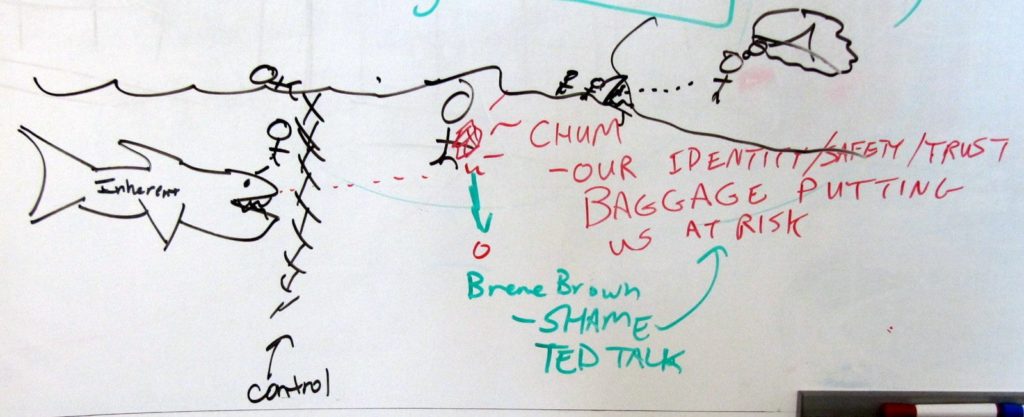 Imagine you are swimming in the water, going about your business. The shark represents the inherent risk in your endeavour. We all carry a chum bag on our back – this represents the perceived risk that is caused by our fears and baggage from the past. Our accomplishments are limited by our safety and trust issues. To help protect us we add controls (the shark net in this metaphor). But this does not allow us to swim beyond in the wider ocean and achieve great results. We notice that in some situations we are so bound by fear that we imagine a shark and will not even venture into the water. This is how limiting our fears can be. We use the title “Entrepreur” for those who overcome their fears and baggage to focus on the inherent (not perceived) risk.
Imagine you are swimming in the water, going about your business. The shark represents the inherent risk in your endeavour. We all carry a chum bag on our back – this represents the perceived risk that is caused by our fears and baggage from the past. Our accomplishments are limited by our safety and trust issues. To help protect us we add controls (the shark net in this metaphor). But this does not allow us to swim beyond in the wider ocean and achieve great results. We notice that in some situations we are so bound by fear that we imagine a shark and will not even venture into the water. This is how limiting our fears can be. We use the title “Entrepreur” for those who overcome their fears and baggage to focus on the inherent (not perceived) risk. 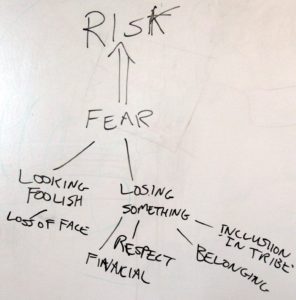
Perceived Risk and Fear
Fear is the driver for perceived risk. It could be fear of loss: Financial loss, looking fooling, or exclusion from a social group. The list of fears we have is very long. Much of this fear has to do with how we as individuals view the world.
Innovation Requires Safety (No Fear)
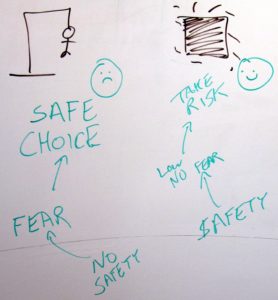 This diagram explains the two dynamics that we can operate in. #1 – “Safe Choice” – if we do not feel safe, we will have fears and therefore make “safe choices”. It could be consider low safety because of intrinsic risk in the environment or it could be because of perceived risk. People can work together as a community to reduce the inherent risk. This is what we mean by guiding teams to add safety and trust. The perceived risk, however, is part of our psyche and it is a personal journey for those who wish to grow away from it. #2 – “Take a Risk” – if we feel safe, we will have low or no fear, and then the door is open to taking risks. In the photo, the door is depicted as dark to indicate the unknown. As the ability to take risks is critical for innovation and learning, we can infer that helping people feel safe is of paramount concern.
This diagram explains the two dynamics that we can operate in. #1 – “Safe Choice” – if we do not feel safe, we will have fears and therefore make “safe choices”. It could be consider low safety because of intrinsic risk in the environment or it could be because of perceived risk. People can work together as a community to reduce the inherent risk. This is what we mean by guiding teams to add safety and trust. The perceived risk, however, is part of our psyche and it is a personal journey for those who wish to grow away from it. #2 – “Take a Risk” – if we feel safe, we will have low or no fear, and then the door is open to taking risks. In the photo, the door is depicted as dark to indicate the unknown. As the ability to take risks is critical for innovation and learning, we can infer that helping people feel safe is of paramount concern.
Success requires Shedding our Fears – Getting Naked
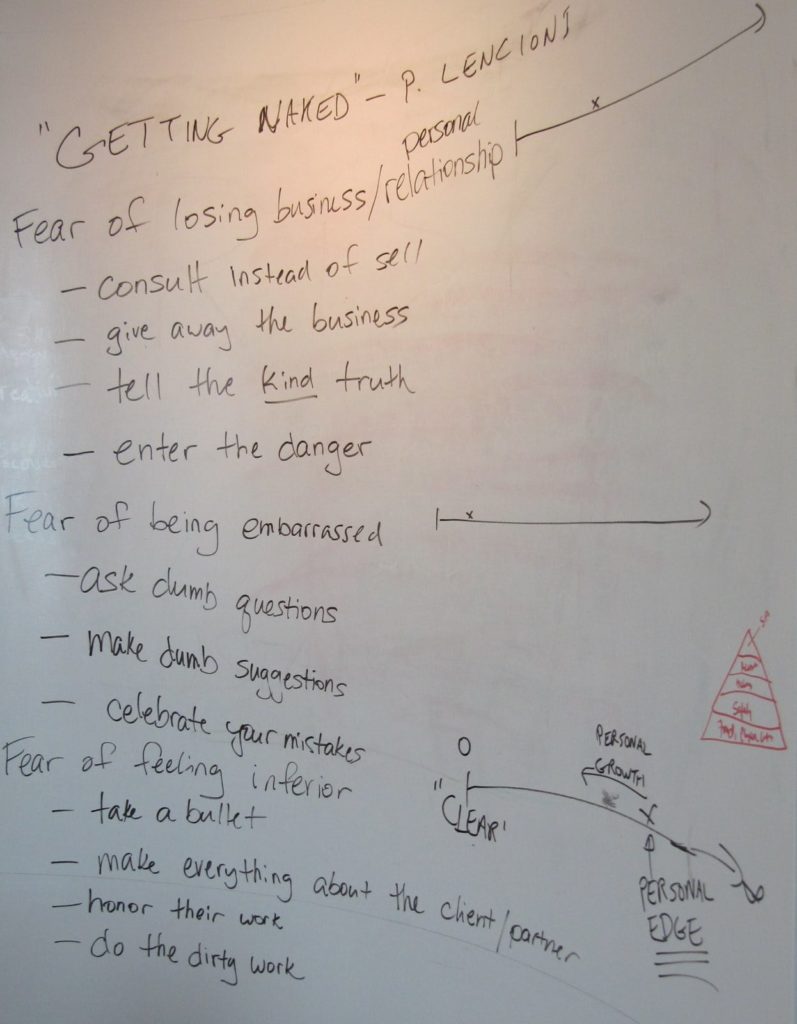 Patrick Lencioni has a wonderful business fable called Getting Naked. It is about the fears that a consultant needs to shed to be effective. Interestingly, it applies to all of those who seek to be personally effective: leaders, managers, change agents, and team members. The book outlines some tactics to describe what naked or fear-free behaviour looks like. For example, to overcome the fear of being embarressed, it suggests one must be able to ask dumb questions, make dumb suggestions and celebrate your mistakes. It is a good start for us to identify and own our fears. The book, however, leaves unanswered the question of how free oneself from fears.
Patrick Lencioni has a wonderful business fable called Getting Naked. It is about the fears that a consultant needs to shed to be effective. Interestingly, it applies to all of those who seek to be personally effective: leaders, managers, change agents, and team members. The book outlines some tactics to describe what naked or fear-free behaviour looks like. For example, to overcome the fear of being embarressed, it suggests one must be able to ask dumb questions, make dumb suggestions and celebrate your mistakes. It is a good start for us to identify and own our fears. The book, however, leaves unanswered the question of how free oneself from fears. 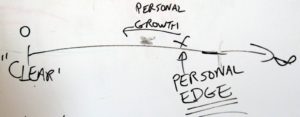
Personal Edge as Model for Overcoming Fear
For each of the fears in getting naked, the diagram illustrates the intensity of that fear: from clear to debilitating. For each fear we have our personal edge – the place where we are at the limit of our capability. Personal growth can be seen as moving this edge towards clear (free of that perceived fear).
Surfing our edge through Flow
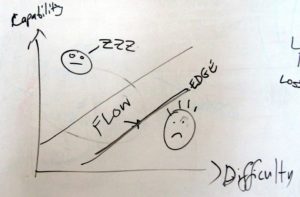 And the flow model provides a great way to surf our own personal edges. We are in a state of flow when the difficulty is matched to our capability. By placing ourselves in situations with the right level of challenge, we can confront a fear and work through releasing it.
And the flow model provides a great way to surf our own personal edges. We are in a state of flow when the difficulty is matched to our capability. By placing ourselves in situations with the right level of challenge, we can confront a fear and work through releasing it.
Shame for Root Cause Analysis on Identity Issues
Let us revisit the chum bag carried by the swimmer that hampers us with perceived risk and fear. The most powerful toolkit I have found for getting to the root cause of identity issues (including fear) is Brene Brown’s book on shame research I thought it was just me. More on this in upcoming blog posts.
Video Summary & Elaboration
If you found this post interesting, please consider watching this 5 minute video that goes into even more detail than covered above. It is a really great summary++. My deep thanks to everyone who participated in this session and to Jade Meskill and Marius Grigoriu in particular.


